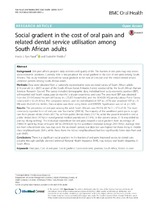| dc.contributor.author | Ayo-Yusuf, Imade J. | |
| dc.contributor.author | Naidoo, Sudeshni | |
| dc.date.accessioned | 2017-06-13T14:17:21Z | |
| dc.date.available | 2017-06-13T14:17:21Z | |
| dc.date.issued | 2016 | |
| dc.identifier.citation | Ayo-Yusuf I.J. & Naidoo S. (2016). Social gradient in the cost of oral pain and related dental service utilisation among South African adults. BioMedicalCenter Oral Health, 16:117 | en_US |
| dc.identifier.issn | 14726831 | |
| dc.identifier.uri | http://hdl.handle.net/10566/2985 | |
| dc.identifier.uri | http://dx.doi.org/10.1186/s12903-016-0313-x | |
| dc.description.abstract | Background: Oral pain affects people's daily activities and quality of life. The burden of oral pain may vary across
socio-economic positions. Currently, little is known about the social gradient in the cost of oral pain among South
Africans. This study therefore assessed the social gradient in the cost of oral pain and the related dental service
utilisation pattern among South African adults.
Methods: Data were obtained from a nationally representative cross-sectional survey of South African adults
?16 year-old (n = 2651) as part of the South African Social Attitudes Survey conducted by the South African Human
Sciences Research Council. The survey included demographic data, individual-level socio-economic position (SEP),
self-reported oral health status, past six months' oral pain experience and cost. The area-level SEP was obtained
from the 2010 General Household Survey (n = 25,653 households) and the 2010/2011Quarterly Labour Force Survey
conducted in South Africa. The composite indices used for individual-level SEP (? = 0.76) and area-level SEP (? = 0.
88) were divided into tertiles. Data analysis was done using t-tests and ANOVA. Significance was set at p < 0.05.
Results: The prevalence of oral pain among the adult South Africans was 19.4 % (95 % CI = 17.2-21.9). The most
commonly reported form of oral pain was 'toothache' (78.9 %). The majority of the wealthiest participants sought
care from private dental clinics (64.7 %), or from public dental clinics (19.7 %), while the poorest tended to visit a
public dental clinic (45 %) or nurse/general medical practitioner (17.4 %). In the poorest areas, 21 % responded to
pain by 'doing nothing'. The individual expenditure for oral pain showed a social gradient from an average of
ZAR61.44 spent by those of lowest SEP to ZAR433.83 by the wealthiest (national average ZAR170.92). Average time
lost from school/work was two days over the six-month period, but days lost was highest for those living in middle
class neighbourhoods (3.41), while those from the richest neighbourhood had lost significantly fewer days from oral
pain (0.64).
Conclusions: There is a significant social gradient in the burden of oral pain. Improved access to dental care,
possibly through carefully planned universal National Health Insurance (NHI), may reduce oral health disparities in
South Africa. | en_US |
| dc.language.iso | en | en_US |
| dc.publisher | BMC Oral Health | |
| dc.rights | All the contents of this journal, except where otherwise noted, is licensed under a Creative Commons Attribution License | |
| dc.subject | Oral pain | en_US |
| dc.subject | Cost of oral pain | en_US |
| dc.subject | Social gradient | en_US |
| dc.subject | Socio-economic position | en_US |
| dc.subject | South Africa | en_US |
| dc.subject | Access to care | en_US |
| dc.title | Social gradient in the cost of oral pain and related dental service utilisation among South African adults | en_US |
| dc.type | Article | en_US |
| dc.description.accreditation | Scopus 2017 | |

